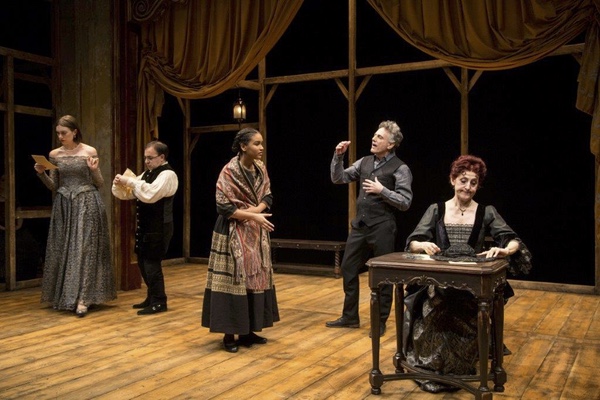This ‘Bridge’ Needs Repair Work (Play)

When Nikolas Cruz strutted through Marjory Stoneman Douglas high school in Broward County, Florida two weeks ago, why did he shoot those particular 17 students? Why not 17 others? Why are some people killed in train wrecks and not others? Why do avalanches trap some skiers and not others? Is it randomness? Bad luck? Or the hand of God?
That is the theme of the 1928 Pulitzer Prize winning novel The Bridge of San Luis Rey, by Thornton Wilder. It was the fictional story about the collapse of a bridge in Peru in 1714 that killed five. Wilder asks was it fate or did people get on the bridge too soon or arrive late?
The novel was turned into a movie several times. Wilder said it should never be a stage play, though, because the conversion would not work.
He was right. This is a theatrical ‘bridge’ that needs repair work.
The first ever play version of the story opened Friday at the Two Rivers Theater, in Red Bank, N.J. It was adapted from the novel by David Greenspan, who starred in it. He changed the story slightly. Now, instead of Brother Juniper telling the story it is Uncle Pio. Greenspan wrote Juniper completely out of the play.
Brother Pio acts much like the Stage Manager in Wilder’s Our Town. He comes on to the stage at the start of the play, tells you to basically close your eyes and pretend you saw the bridge fall. Then the play starts. Uncle Pio tries to connect the pre-collapse stories of the five who died and some other people. The point is that they were on that bridge at that moment for no particular reason and wound up dead. Members of the audience are then left to argue if it was bad luck or Providence.
The problem with the drama is that it does not argue randomness at all. It just says the bridge collapsed and people died. The people who died on it had little to do with each other and Uncle Pio can jump up and down and waves his arms until the moon turns blue and he is not going to make it so.
Their individual stories are mildly interesting. One mother sends savage letters to her daughter, who writes back similar horrid notes. An annoying actress alienates everybody and then quits the stage. One twin brother accidentally cuts his leg and dies from the injury. They do not hold together, though, and do not hold up the play.
Another problem with the play is that since you know the five are going to die the script has no emotional wallop to it. There are also too many letters being written and read on stage. This play has more letters than the Chicago Post Office.
There is a lot of talent on stage. Uncle Pio is played with splendor, and eloquence, by Greenspan. He is a marvel as he races from scene to scene and quickly moves the story along. Director Ken Rus Schmoll gets other fine performances from Mary Lou Rosato as Dona
Maria, Madeline Wise as Dona Clara, Sumaya Bouhbal as Pepita, Julienne Hanzelka Ka Kim as the nun, Zachary Infante as Esteban, the twin brother of Manuel (Bradley James Tejeda), Steven Rattazzi as Don Vicente, and Elizabeth Ramos as Camila.
There is little 1714 Peruvian history in the show or attention to a crisis. Nobody in 18th century Peru knew the bridge was in poor condition? Nobody launched an investigation after it fell? It is fascinating, though, to watch the mother and daughter complain about how long it takes a letter from each to reach the other across South America and the Atlantic in 1714. Today, they could bark at each other through the texts on their phones.
Thornton Wilder, up in literary heaven, must be looking down, shaking his head and whispering “I told you so…”
PRODUCTION: The play is produced by the Two Rivers Theater. Sets: Antje Ellermann, Costumes: Elizabeth Hope Clancy, Lighting Design: Yuki Nakase, Wig Design: David Bova. The play is directed by Ken Rus Schmoll. It runs through March 18.